Fun 3-Step Growing Gummy Hearts Experiment
In this amazing growing gummy hearts experiment, your kids will have a blast finding out how big the hearts will grow, how long it will take, and if the substance has anything to do with it.
Looking for more activities like this? Check out these awesome Valentine’s Day Science Activities that kids will love.
The experiment I’m sharing today is one your kids will enjoy eating as much as watching. To make it more interesting, use the Scientific Method to help your kids creatively think about what they think will happen and why.
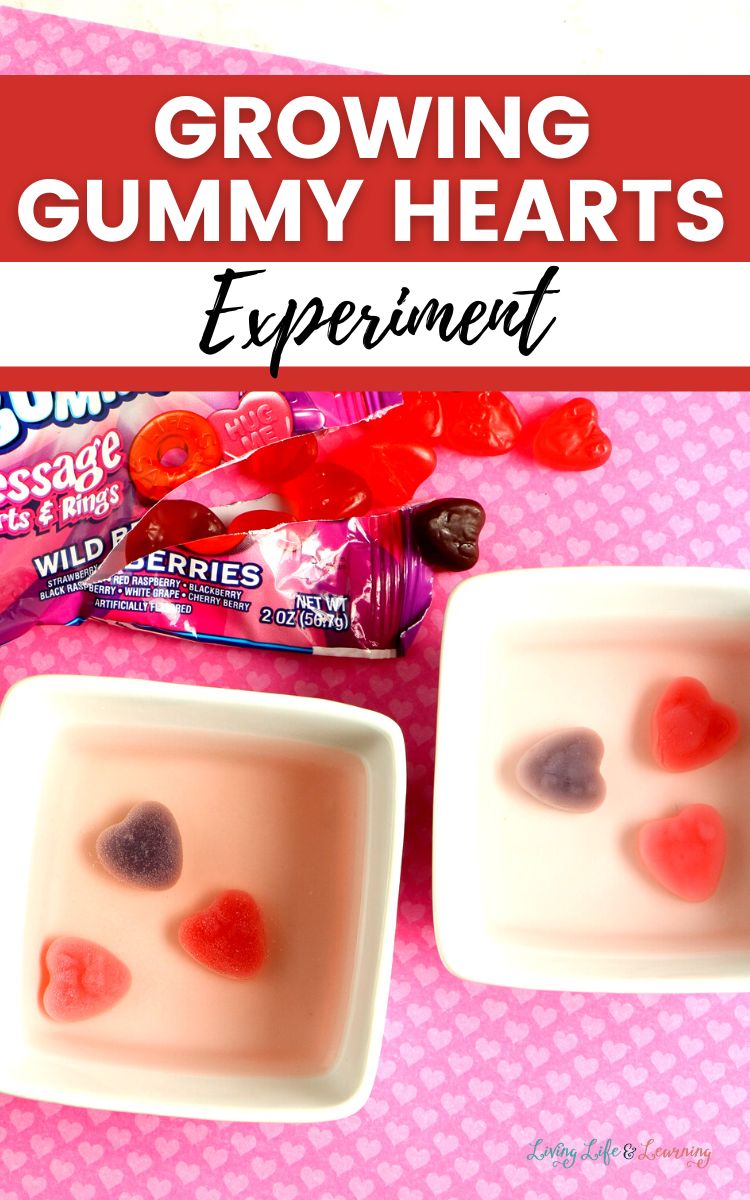
This post may contain affiliate links meaning I get commissions for purchases made through links in this post. Read my disclosure policy here.
What makes the gummy hearts grow?
Because there are two different solutions for this experiment, one being plain water and the other being a saltwater mix, there are several scientific factors to consider. If you are using table salt, it is the compound sodium chloride.
If you are using sea salt, then its chemical makeup retains more minerals due to coming from evaporated seawater. There’s also Himalayan salt, which is made up of 98% sodium chloride, and the remainder being potassium, magnesium, and calcium.
Of course, to see if these individual salts make a difference in the outcome, you’d have to try them all out (which would be another cool experiment)!
With the water-only solution, there are similar factors to include:
- Purified water is water that has been stripped of the majority of its chemicals and impurities.
- Distilled water is quite like purified water and most of the dissolved substances have been moved by evaporation.
- Spring water is considered the most natural as it uses subterranean water that has risen to the surface.
So, again, to see if the kind of water used has an effect on the growing gummy hearts experiment, you’d have to try it with the different types.
Overall, regardless of what kind of salt and water you choose to use, it’s the liquid that will cause the gummy hearts to grow. But how big is the question?
Recommended Science Experiment Books
Love this candy science experiment. Grab one of these science experiment books for even more ideas to help your kids get curious and discover new ideas.
Recommended Science Experiment Books
Looking to add more ‘wow’ to your science explorations? Well, look no further! I’ve handpicked a whole library of the most amazing Science Experiment Books that are perfect for inquisitive kiddos like yours!
Awesome Science Experiments for Kids: 100+ Fun STEM / STEAM Projects and Why They Work (Awesome STEAM Activities for Kids)The Everything Kids’ Science Experiments Book: Boil Ice, Float Water, Measure Gravity-Challenge the World Around You!Awesome Kitchen Science Experiments for Kids: 50 STEAM Projects You Can Eat! (Awesome STEAM Activities for Kids)Awesome Outdoor Science Experiments for Kids: 50+ STEAM Projects and Why They Work (Awesome STEAM Activities for Kids)Steve Spangler’s Super-Cool Science Experiments for Kids: 50 mind-blowing STEM projects you can do at homeSmithsonian 10-Minute Science Experiments: 50+ quick, easy and awesome projects for kids
Recommended Valentine’s Day Activity Kits
Little Learners Print & Go Activity Kit: Valentine’s Day
Valentine’s Day is here and learning doesn’t have to be a bore. Get this huge pack of printable math and literacy activities from math worksheets to alphabet puzzles.
Valentine’s Day Foam Crafts Set
Valentine’s Day is the perfect day to get crafty! Grab this craft kit for your child and let their creativity run wild!
The Science Behind the Growing Gummy Hearts Experiment
When the gummies are added to water, the water molecules move into the bear through a process called osmosis. The gelatin ingredient found in the gummies then acts like a sponge and soaks up some of the water. Some may think the water would cause the gummy to dissolve. But it doesn’t.
In the saltwater, water moves out of the gelatin because there are more salt molecules in the saltwater than there are in the gummy hearts. This may cause the gummy in this solution to shrink – or will it?
There are lots of good hypothetical questions that could be asked beforehand and then tested out in this experiment. Be sure to document any questions your kids ask so you can go back and answer them.
If you enjoy this experiment, you may want to check out our other Valentine’s Day-inspired activities! You’ll find an activity for every season.
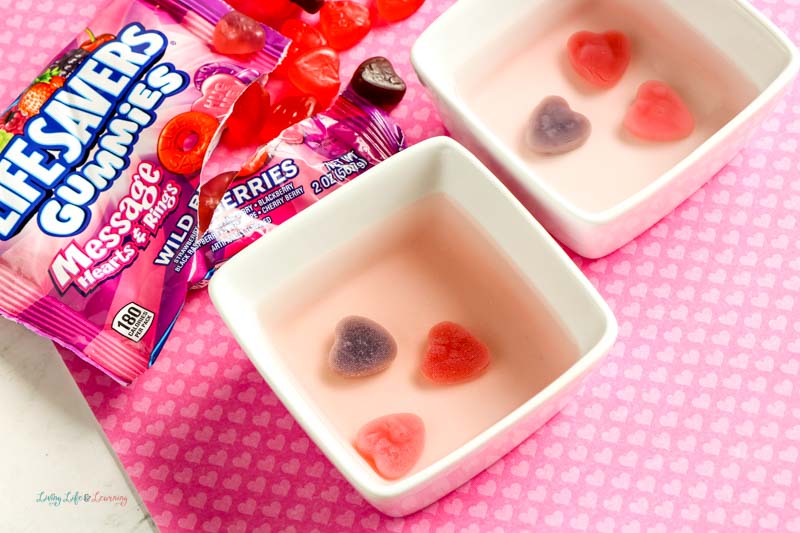
For this experiment, you can get all hands on deck. Younger kids can work on their small motor skills by pouring water into a container and stirring salt and water together to create the salt-water solution. For older kids, encourage them to use the Scientific Method and form an educated guess on what they think the results will be.
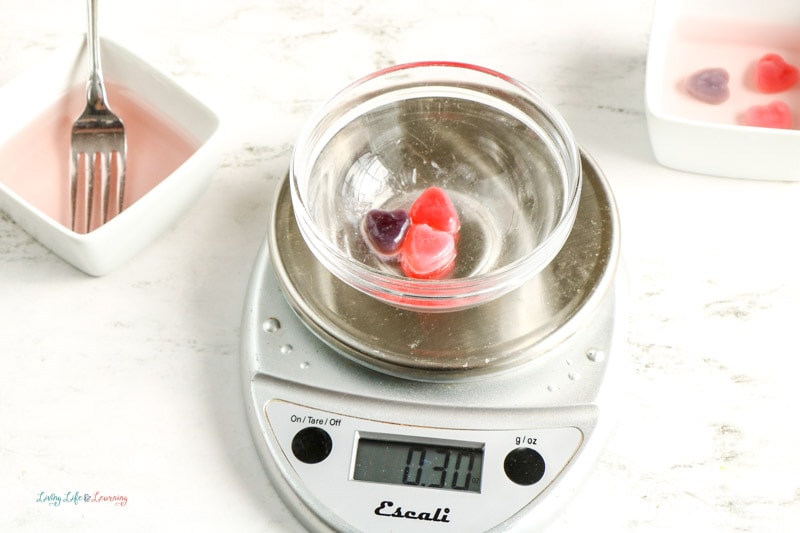
Once you have your ingredients together (listed below), make sure you get accurate measurements and have each batch the same weight. If you’d like to get multiple subjects in using this experiment, now is the time for adding in a quick math lesson.
Have your children create a simple graph or chart using the gummy hearts. Create two columns on a piece of paper. In one column your kids can write the number of hearts from one to ten. In the second column, they can document the weight of the corresponding number of hearts.
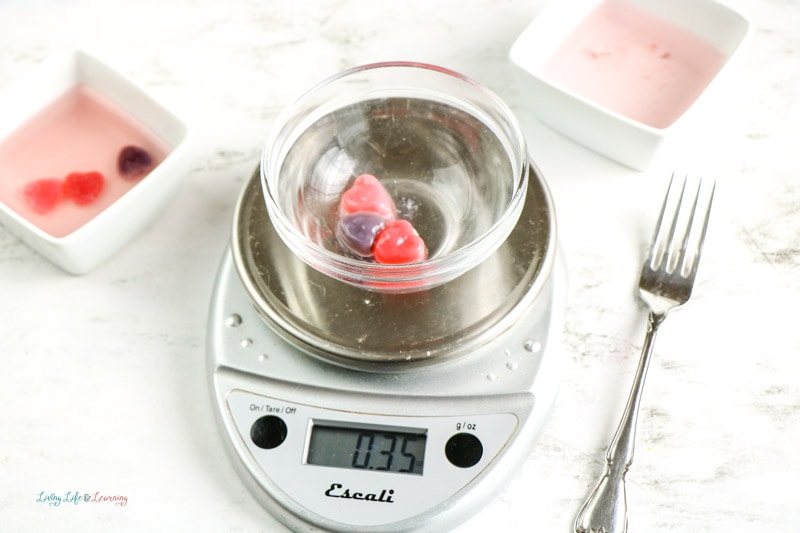
Another math and measurement step in this gummy hearts experiment is weighing them once they have grown. Test your kids’ addition and subtraction skills by figuring out how much more they weigh since having absorbed some of the water and salt-water solutions.
This is something else that can documented on a graph or chart.
Recommended Valentine’s Day Books
Bring more excitement to the season with these Valentine’s books for little kids. You will love these great stories about hearts, love, and Valentine’s Day.
Day It Rained HeartsThe Biggest Valentine EverTurkey’s Valentine Surprise (Turkey Trouble Book 6)There Was an Old Lady Who Swallowed a Rose!A Crankenstein ValentineLove, Escargot
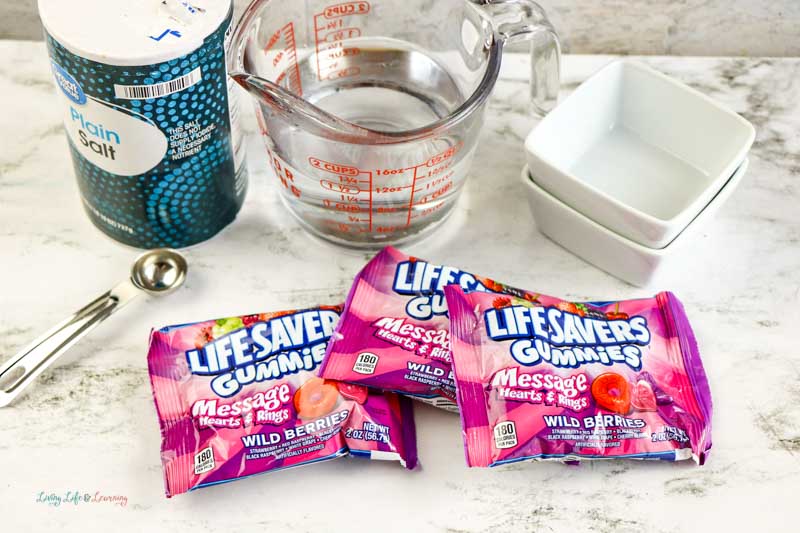
Growing Gummy Hearts Experiment Supplies
- Gummy heart candies
- 1 tablespoon salt
- 2 cups water, divided
- 2 bowls
Candy Shop Red & White Sour Gummy Hearts, Sugar Sanded Candy, 1 Lb Bag6PCS 4.5 OZ Wheat Straw Small Dessert Bowls, Stacked Pinch Bowls, Bamboo Fiber Mini Prep Bowls, Unbreakable Dipping Saucers for Side Dishes, Seasoning, Snack, Appetizer (Multicolor)Morton Iodized Table Salt, 26 Oz, pack of 2
How to do the Growing Gummy Hearts Experiment:
- In one bowl, add 1 cup water.
- In the other bowl, combine the remaining water with salt, stirring until the salt is dissolved.
- Place two to three gummies in each bowl. Allow to rest for several hours overnight.
- Observe changes in the gummies.
- If desired, remove the gummies from the water and weigh them on a kitchen scale.
To create a measurement foundation, keep several gummies out to serve as the control. Then you’ll be able to measure the growth based on the original shape and size.
Ask your kids to describe what they see and what they thought the end result of the growing gummy hearts experiment would be.
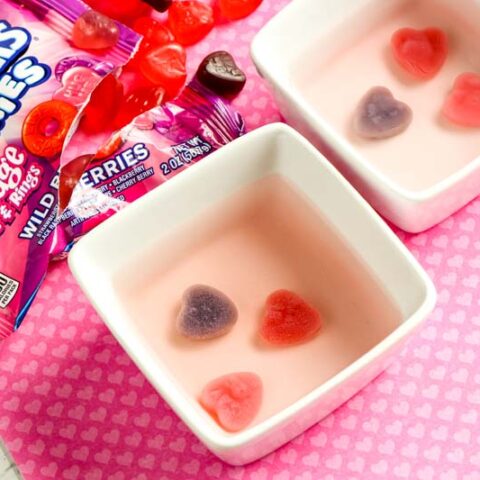
Growing Gummy Hearts Experiment
Materials
- Gummy heart candies
- 1 tablespoon salt
- 2 cups water, divided
- 2 bowls
- Weighing scale (optional)
Instructions
- Add one cup of water to a bowl.
- In another bowl, dissolve the salt in one cup of water.
- Place two to three gummies in each bowl. Allow to rest for several hours overnight.
- Let kids observe changes in the gummies and take notes.
- They can remove the gummies from the water and weigh them on a kitchen scale.
I’d like to hear from you! Did you do this experiment? Let me know in the comments below!
More Valentine’s Day Activities
Looking for a way to incorporate science and Valentine’s Day? Here is a list of simple heart experiments that are Valentine’s Day-themed!
If your kids love STEM activities, you must try these Valentine STEM Activities packed with exciting science experiments, slime recipes, engineering a structure challenge, and more!
These heart activities are super simple and fun! Perfect for toddlers’ little hands!
Candy Heart Science Experiments
Are you looking for a fun activity that involves candy hearts or conversation hearts? Look no further than these candy heart Science experiments!
Valentine STEM Activities for Kindergarten
Fizzy Hearts Science Experiment
Heart Jelly Beans STEM Challenge
Valentine’s Day Coding Activity by Little Bins for Little Hands
3D Heart Marshmallow Structure by Messy Little Monsters


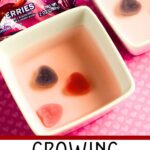


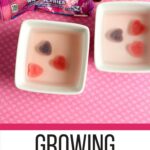
















I am having a hard time finding gummy hearts will other gummy candy work as well?
Yes, you can do this with any type of gummy candy.